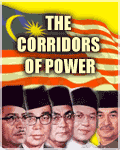
Hence we can see how critical these drops or increases can be. A 12.7% drop in Kedah, 17.5% drop in Penang, 12.6% drop in Perak, and 20.8% drop in Selangor, gave Pakatan Rakyat those states. However, to win those states, Pakatan Rakyat must win at least 55% of the popular votes. 50% is not enough. At 50%, Barisan Nasional will still be the government. In fact, all Barisan Nasional needs is 47%-48% to stay in power.
THE CORRIDORS OF POWER
Raja Petra Kamarudin
3.3 million problematic voters in electoral roll
(Malaysiakini) - There are 3.3 million cases of dubious voters in the electoral roll, claimed researcher Ong Kian Ming, a large chunk of which is made up of those voting in constituencies different from the addresses shown on their identification cards (MyKad).
Based on a-decade-old data, Ong said that there are 3.1 million voters who vote in constituencies that do not tally with the address stated on their MyKads.
“(This) is particularly troubling because this information was given to the Election Commission (EC) by the National Registration Department (NRD) in 2002,” said Ong at a press conference organised by the Coalition for Clean and Fair Elections (Bersih 2.0).
Ong, who is the director of the Malaysia Electoral Roll Analysis Project (Merap), said that he came into possession of the data almost 10 years ago as well. However, he managed to compile the additional information needed in one week.
************************************
Because only two coalitions will be contesting every seat in the next general election, Malaysians, therefore, are being allowed only two alternatives, Barisan Nasional or Pakatan Rakyat. No doubt there may be other contenders, but since they will be contesting only a couple of seats, they would not be able to offer themselves as a possible state or federal government. Hence we have to look at this based on either Barisan Nasional or Pakatan Rakyat.
Now, if you think that the 2008 general election was a close finish, wait till you see the results of this next election. It may be an even closer finish that could result in various constituencies having to do a recount, thus delaying the announcement of the election results in those constituencies.
First look at this graphic.

In 2004, PAS and Umno almost tied in Kelantan. That resulted in PAS ruling the state with only a one-seat majority. In 2008, when Pakatan Rakyat was able to increase its share of the popular votes by an additional 5.8%, it managed to get a clear majority, 39 seats versus Umno’s six. Hence, 5.8% more votes made a difference between a one-seat majority and a 33-seat majority.
In 2004, Barisan Nasional won 64.1% of the popular votes in Selangor and ruled the state with a clear majority. In 2008, it dropped 20.8% to 43.4% resulting in Pakatan Rakyat taking the state with a 16-seat majority.
In 2004, Barisan Nasional won 57.9% of the popular votes in Perak and ruled the state with a clear majority. In 2008, it dropped 12.6% to 45.3% resulting in Pakatan Rakyat taking the state with a three-seat majority.
In 2004, Barisan Nasional won 55.7% of the popular votes in Penang and ruled the state with a clear majority. In 2008, it dropped 17.5% to 38.2% resulting in Pakatan Rakyat taking the state with an 18-seat majority.
In 2004, Barisan Nasional won 58.5% of the popular votes in Kedah and ruled the state with a clear majority. In 2008, it dropped 12.7% to 45.8% resulting in Pakatan Rakyat taking over the state with a seven-seat majority.
Barisan Nasional also saw a drop in popular votes in Perlis (3.7%), Terengganu (1.2%), Pahang (8.1%), Negeri Sembilan (14.5%), Melaka (13.4%), and Johor (14%). But they still ruled these states because, in spite of the drop, Barisan Nasional still won 53%-63% of the popular votes. Only when the popular votes drop below 46% can Barisan Nasional lose the state.
Hence we can see how critical these drops or increases can be. A 12.7% drop in Kedah, 17.5% drop in Penang, 12.6% drop in Perak, and 20.8% drop in Selangor, gave Pakatan Rakyat those states. However, to win those states, Pakatan Rakyat must win at least 55% of the popular votes. 50% is not enough. At 50%, Barisan Nasional will still be the government. In fact, all Barisan Nasional needs is 47%-48% to stay in power.

Now, how would Barisan Nasional ensure that it will not lose more states the next time around and can also win back the states it lost in 2008? Simple, move 5% of the opposition voters out and inject 15% pro-government voters into the electoral roll. Pakatan Rakyat would be sure to get wiped out.
Basically, half the voters are going to vote opposition and the other half ruling party. Hence it is a draw. So that means it is very easy to manipulate the electoral roll. Penang and Kuala Lumpur would be a bit more difficult though. But Kelantan, Kedah, Perak and Selangor would be easier. They only need a 10% margin. So, by removing 5% and adding 15%, that would be achieved easily enough.
And that is how Barisan Nasional is going to continue to rule, unless Pakatan Rakyat can win 55% of the popular votes. And we are talking about 55% with cheating, mind you. This means Pakatan Rakyat needs to win at least 65% of the popular votes to offset the cheating.
Boleh ke?


No comments:
Post a Comment
Note: Only a member of this blog may post a comment.